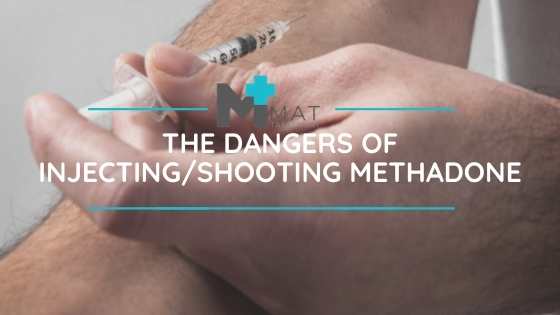Table of Contents
Methadone is a drug that’s used most often in medication-assisted treatment (MAT) rehab programs. It functions as an effective opioid replacement medication, helping patients in recovery reduce their reliance on other narcotics like heroin.
Unfortunately, if used incorrectly or outside of a regulated rehab program, methadone can become an addiction of its own.
As with other opioids, shooting methadone or otherwise abusing it can be extremely dangerous. Keep reading to learn more about the risks associated with abusing methadone intravenously and how to identify the signs of an overdose.
Table of Contents
Dangers Associated With Shooting Methadone
Because it acts on the same brain receptors as other opioids, the primary risk of injecting methadone is becoming dependent on it.
Many people believe they can manage their methadone use and avoid developing an addiction. As your body becomes tolerant to the substance, however, you’ll find that you need larger or more frequent doses to get high. The more dependent you become, the greater your chance of overdose.
For people who were already in treatment for heroin abuse, even the act of shooting up can be addictive in and of itself. Let’s take a closer look at some of the other methadone side effects and injection risks that users may experience.
It Takes a Toll on Your Mental Health
Mental illness and opioid use have a cyclical relationship.
Many people who struggle with their mental health turn to narcotic drugs to numb the pain or distract them from their thoughts. On the flip side, those who use opioids can experience low mood and suicidal thoughts as a side effect. In drug users with pre-existing mental illness, opioids often worsen their existing symptoms instead of blocking them out.
Even though methadone isn’t as potent as some other opioids, it can still negatively impact your mental health in a huge way. If you’re dealing with mental illness and methadone use, it’s vital to talk with a licensed addiction counselor as soon as possible.
Drug Interactions
Like other opioids, methadone can interact with other prescription medicines or illicit drugs.
It’s most dangerous when taken with other depressants or “downers”. The consequences can include heart and respiratory failure. People with existing cardiovascular problems are at the highest risk of fatal complications.
The drugs and medicines that can interact with methadone include:
- Barbiturates
- Cocaine and other stimulants
- Benzodiazepine
- Tramadol
- Naltrexone
- Amprenavir
- Amitriptyline
Methadone can also be dangerous when taken with alcoholic beverages. Alcohol lowers your inhibitions, making even “responsible” users more likely to overdose. It can also increase the depressive side effects of opioids.
Dangerous Additives
When taken under medical supervision as part of an opioid treatment program (OTP), methadone is an oral medication (swallowed in pill form). When shooting methadone, users often crush and dissolve these pills to inject them. This is harmful for two main reasons.
First, drug manufacturers must design oral medications to break down once they reach the stomach, not before. This means they often coat the pills in inactive additives like sorbitol and glycerin. These chemicals can break down when they hit stomach acid, but they won’t degrade in your bloodstream.
Second, crushed pills can send sharp particles flowing through your veins, even if you try to filter them out first. These particles can do considerable damage to your blood vessels. They can also travel to your lungs and heart, causing potentially fatal tears in delicate tissue.
Risks Associated With Using Drugs Intravenously
Whether you’re injecting methadone or another drug, there are quite a few risks aside from the drug’s effects that come with shooting up.
The largest risk for most users is that of infection. Using needles outside of a sterile healthcare environment can introduce dangerous pathogens into your bloodstream. You could easily end up with a staph infection or a dangerous case of MRSA that leaves you with permanent tissue damage.
If you share needles with other people, you’re also at risk of spreading diseases between each other. Bacterial infections can spread like wildfire this way. The largest concern, though, is the chance of contracting a bloodborne virus such as Hepatitis or HIV.
Signs of Methadone Overdose
One of the largest dangers associated with shooting methadone is the risk of overdose. Unlike other opioids, methadone stays in your system for days at a time, even though the high wears off after a few hours. This leads many users to inject more of the drug before the last dose has cleared their system, drastically increasing the drug’s toxic effects.
The signs of a methadone overdose are similar to those of other opioid and narcotic drugs. They can include:
- Slow, shallow breathing
- Constricted “pinpoint” pupils
- Muscle fatigue and weakness
- Cold sweats and clammy skin
- Slow and/or weak heartbeat
- Severe or sudden and persistent drowsiness, difficulty staying awake or waking up
- Loss of consciousness or “passing out”
If you think you or someone else might be experiencing a methadone overdose, seek medical attention immediately. Don’t leave them alone to “sleep it off”, as they may never wake up. Overdosing on this substance can quickly lead to death without the right interventions.
Are You Battling a Methadone Drug Addiction?
If you’re struggling with shooting methadone or another substance abuse disorder, don’t try to face your addictions alone. Getting professional support is the best way to start a successful recovery journey.
For more informative content about substance abuse and recovery, keep reading through the rest of our blog. If you have any questions about getting treatment, staging an intervention, or getting admitted to a rehab program, don’t hesitate to contact us online or by phone. Our admission representatives are ready to help connect you with the resources you need.
Get Help Today
Don’t go through the process of recovery alone. There are people who can help you with the struggle you’re facing. Get in touch with one today.



